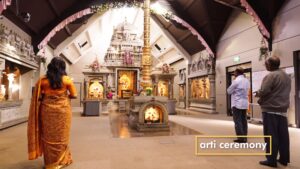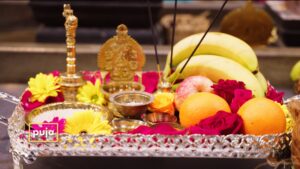Holy Cribs: The Mandir
Pranathi gives TrueTube a tour of The Shree Ghanapathy Mandir in South London, explaining its most important features and her beliefs as a Hindu.
Curriculum Mapping
Component 1: The study of religions: beliefs, teaching and practices: Hinduism - Different forms of worship: puja and arati - The rituals of puja and arati and their significance for Hindus.
Area of Study 2 – Hinduism - Section 3: Living the Hindu Life - The nature and purpose of prayer in the temple and the home: the nature, features of use and purpose of the different forms of worship, including meditation, puja, havan, darshan, arti, bhajan, kirtan and japa, with reference to interpretations of Bhagavad Gita 6.44–47; divergent understandings of the benefits for Hindus of having different forms of worship.
Component Group 1 - Beliefs and teachings & Practices - Hinduism - Approaching deity •Different Hindu understandings of the role,forms and importance of the following types of worship: •• Havan or homa •• Puja •• Meditation •• Japa •• Bhajan or kirtan •• Darshan • The nature and importance of sacred places and spaces for Hindu worship: •• Temples •• Shrines •• Sites of pilgrimage •• Outdoors •• Hills and rivers
2.1 Unit 1 PART A - Hinduism - Core beliefs, teachings and practices - Practices Worship Features and importance of daily puja in the home: (Bhagavad Gita 3:19, 4:38) Features and importance of congregational puja in the mandir (including devotions to the murti, arti and havan) Diversity in Vaishnavite and Shaivite worship Significance of bhakti Role, importance and features of pilgrimage to Varanasi
2.3 Component 3 (Route A) - Option 2: Hinduism - Places of worship in Britain and elsewhere ➢ Features and importance of daily puja in the home ➢ Features and importance of congregational puja in the mandir ➢ Diversity of views and practices: Vaishnava and Shaiva bhakti ➢ Hindu mandirs in Britain compared to those in India ➢ Features and importance of worship at outdoor shrines Worship/meditation ➢ The significance of different forms of worship/meditation; havan, puja, arati, darshan Bhagavad Gita 9.26, bhajan/kirtan, japa: Bhagavad Gita 3.19, 4.38, 6.11–12 ➢ The importance of focuses of worship and representations of the divine; one god, other deities, holy land, plants and animals: Bhagavad Gita 16.24 ➢ Honouring Gurus and elders
Transcript
Holy Cribs: The Mandir
Pranathi: Welcome to the Shree Ghanapathy Temple. My name is Pranathi and I'm a Hindu. This is a temple or mandir and my dad is one of the priests here, so it's like a second home to me. We come here to worship Brahman, the one supreme spirit which we believe lives in all things. We worship many forms of Brahman, but this temple is especially dedicated to Lord Ganesha. Traditional mandirs usually have a gateway or a tower called a gopuram, which lets you know you're entering a special place. You may also find a statue of an animal or god outside. This is Ganesha, the elephant headed god of wisdom. This is the normal entrance for the mandir. The word mandir comes from the word 'house' in the ancient Indian language of Sanskrit. We think of the temple as a home for the deities, what we call the gods and goddesses that are inside. When we come into the temple, we respect it like you would when entering the home of a very important person. The entrance area of the mandir is called an ardhamandapa. It's where we take off our shoes and leave them in these racks. This is so we can keep the inside of the building as clean as possible, as another sign of respect. Also, some girls and women like to cover their heads when they come into the mandir. As people enter, they will often ring a bell to announce their arrival, just like you would ring on someone's doorbell.
On special occasions, we will open the main doors of the temple and you'll often see people bending down to touch the steps before they enter. In India, it's tradition that we touch the feet of those we respect, and the step represents the feet of the deities. By the door, this is Bhairavar. He is the protector or guardian of our temple. This is the mandapa, the main prayer hall of the mandir. All around the mandapa, there are deities. Each one has a shrine or vimana, which is a small area of worship. A statue of a deity is called a murti. We treat them as honoured guests, and so they are washed, decorated and given offerings of food every day, as signs of respect to the gods or goddesses they represent. I said outside that we worship one supreme spirit called Brahman who was a part of all things. So each one of the deities is Brahman in human or animal form. They show us many different ways to understand Brahman.
This mandir is dedicated to Ganesha, but most mandirs will have a murti of Ganesha near the door. He is a very popular deity because he removes obstacles or problems in people's lives. This is Shiva with his wife, Parvati. We also have murtis of Vishnu and we believe he has come to Earth in different forms. So here he is, as Krishna with Radha. And as Rama with Sita. Puja is the Hindu name for worship or prayer.
A tray is often laid out with various objects to help Hindus in their worship. Fruit, rice, flowers, water, a lamp, holy ash and kumkum powder, incense, a bell. There will be items to touch, taste, smell, hear and look at. All five senses are involved as a symbol that the whole person is devoted to the deity. Prasad is food like fruit, nuts or sweets that is offered to the murtis and then shared out after the puja. We believe that the deities bless the food during the puja. And so if we eat the prasad we will be blessed too. Take a sniff. Incense is burned in mandirs to purify the air, hiding any nasty smells. It also creates an atmosphere that always makes me think of puja. So it helps me to get in the right frame of mind to pray. The main shrine at the front of the mandapa is called a garbha griha, which means womb house. It symbolises the womb or heart of the body because we believe it gives life to the whole mandir. Inside the garbha griha will be a murti of the main deity that the mandir is dedicated to; the deity that most people come to this mandir to worship, which in our case is Ganesha. There is a space or corridor around the garbha griha called the pradakshina. This is so people can walk clockwise all around it. It shows that just like the shrine is at the centre of the circle I'm making as I walk around it, Ganesha is at the centre of my life. Directly above the garbha griha, some mandirs have a spire on the roof called a shikara, or they might even have several shikaras above all the different shrines. They symbolise the Himalayas, the mountains in India, where the deities were believed to live. In fact, shikara means 'mountain peak'. Some mandirs have flags, and the colour of the flags show which deity the mandir is dedicated to. So orange for Shiva and his family, which includes his son Ganesha; and red and white stripes for Swaminarayan.
Our priests traditionally come from the Brahmin varna, the top varna or caste in the Indian class system. He's called a pujari, someone who leads puja. This is the arti ceremony. The pujari uses a lamp with five wicks to symbolise the five traditional elements of earth, air, fire, water and space. He waves it in front of the murtis while chanting a prayer. And people ring bells and blow a shankha. A shankha or conch is a huge seashell. And if you blow into it properly, it makes... That sound. The lamp is blessed by the deities during the arti prayer, and then it's taken round the mandapa for us to pass our hands over the flames and then touch our heads to show that we are accepting the deity's blessing.
Mandirs are usually full of decorations and symbols. This one is called the Om, which represents Brahman, the one unseen spirit. The lotus flower grows out of a muddy riverbed to float on the surface, looking all beautiful. So it symbolises that we should try to be pure, even when the world around us is often polluted. And the swastika which represents the sun and God's blessings. Although this one is often misunderstood because it was used by the Nazis in the Second World War, it's a shame because the symbol of blessing was turned into a symbol of hate. But that's not what it means to me. Many mandirs have a hall or other rooms attached that can be used for meetings, education, festivals and lots of other events. And that's it. Thanks for coming to the Shree Ghanapathy Temple. Don't forget your shoes. Thanks for coming, guys. Bye.








